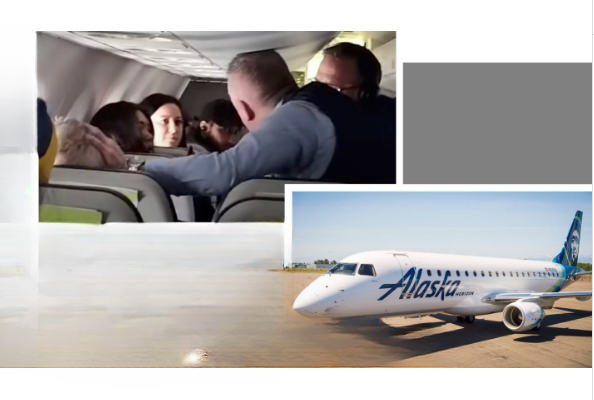Air travel has long been a symbol of human progress — a way for people to cross vast distances within hours, connecting cities, cultures, and communities. For many travelers, flying has become an ordinary part of daily life, filled with familiar sounds: the rumble of engines, the polite announcements from cabin crews, and the quiet hum of passengers finding their seats. Yet, even in such routine moments, the unpredictable can occur, revealing the true strength of preparation, training, and human cooperation.
One such example unfolded aboard Alaska Airlines Flight 2221, a domestic flight traveling from Oakland, California, to Portland, Oregon. What began as a simple journey soon became a powerful example of how professionalism, teamwork, and empathy can overcome sudden challenges. While the event itself was managed calmly and safely, it became a moment that reaffirmed essential values in aviation — preparedness, awareness, and unity under pressure.
The Routine Beginning of Flight 2221
As passengers boarded Flight 2221, the atmosphere was relaxed and routine. Families with children settled near the windows, business travelers opened their laptops, and others scrolled through playlists or books on their devices. The flight attendants, dressed in Alaska Airlines’ signature uniform, guided travelers with friendly smiles, helping with luggage and providing brief but important safety instructions.
The aircraft taxied smoothly down the runway, and within minutes, it lifted into the soft blue sky above California. Everything felt ordinary — until the unexpected occurred.
A Sudden Disruption Midair
Shortly after reaching cruising altitude, the calm atmosphere was interrupted when one passenger began showing signs of visible distress. Witnesses later described the scene not as chaotic, but concerning — a clear sign that something was wrong. The individual appeared confused and anxious, showing behaviors that signaled a mental health episode.
What made this incident significant wasn’t just the nature of the event but the way it was handled. In the confined space of an aircraft, even minor disturbances can quickly escalate. However, on Flight 2221, the professionalism of the crew and the supportive reaction of passengers transformed what could have been a dangerous situation into a powerful demonstration of composure and teamwork.
Calm Leadership from the Crew
Flight attendants are the unsung heroes of aviation. While passengers often associate them with in-flight service, their primary responsibility is safety. They undergo hundreds of hours of emergency training, learning how to respond to medical situations, mechanical issues, and passenger incidents of all kinds.
On this particular flight, the crew’s calm demeanor was key. They immediately assessed the situation, using clear communication and empathy to de-escalate tension. Their professionalism prevented panic and reassured passengers that everything was under control.
Their ability to stay composed not only maintained safety but also inspired confidence throughout the cabin — a reminder of how leadership under stress can shape outcomes in critical moments.
Teamwork Among Passengers
While the flight attendants led the response, several passengers quickly stepped up to help. Working under guidance from the crew, they helped ensure that everyone — including the distressed individual — remained safe.
Their cooperation was crucial. Rather than acting out of fear, they acted out of awareness and compassion, which made all the difference. Together, they created a secure environment where the passenger in crisis could be assisted without harm.
This collaborative effort serves as a model for how ordinary individuals can contribute meaningfully in moments of urgency. It’s a reminder that teamwork isn’t limited to workplaces or sports fields — it’s something that matters deeply in everyday life, especially when lives and safety are at stake.
Safe Landing and Supportive Resolution
As the plane began its descent into Portland International Airport, the cabin remained calm. The crew communicated with ground control and local authorities, ensuring that appropriate medical professionals were ready to assist the passenger upon arrival.
Once the aircraft landed, the individual was safely escorted for medical evaluation and mental health support. The situation was resolved peacefully, without any harm to passengers or crew. The coordinated efforts of everyone onboard — from pilots to passengers — turned what could have been a frightening experience into a model example of effective crisis management.
The Broader Message: Preparedness and Empathy
Flight 2221’s experience highlights several valuable lessons that go beyond aviation. It illustrates how training, quick thinking, and empathy can transform challenges into learning experiences. The story is not one of danger but of readiness and compassion — principles that apply to every part of life.
- Preparedness Saves Lives:
Airline staff are trained for a wide variety of situations, including medical and behavioral emergencies. This training allows them to stay composed and effective, even when events take an unexpected turn. - Empathy Matters:
In times of crisis, kindness can calm panic. Treating others with respect, patience, and understanding creates trust — a key element in resolving difficult moments. - Teamwork Is Powerful:
Cooperation between passengers and crew proved that unity can overcome uncertainty. Working together transformed potential chaos into calm control. - Mental Health Awareness Is Essential:
The event also brings attention to the growing importance of mental health in travel environments. Airlines are increasingly aware of how psychological factors can affect both passengers and staff.
Understanding Mental Health in the Context of Air Travel
Modern air travel can be stressful — not just physically, but emotionally. Tight schedules, crowded airports, and high altitudes can create anxiety for some travelers. For individuals already managing mental health conditions, flying can occasionally trigger discomfort or distress.
Airlines today are more aware than ever of this reality. Many carriers now collaborate with mental health professionals to provide staff training, awareness programs, and better in-flight communication strategies. The goal is to ensure that every traveler feels safe and supported, no matter what challenges arise.
Moreover, by reducing stigma and promoting open discussion, society as a whole can better understand and address these issues. Recognizing signs of distress — and responding with empathy rather than judgment — is a small but powerful step toward a safer and more compassionate travel experience.
Training and Protocols: The Backbone of Aviation Safety
Behind every smooth flight is a well-structured system of protocols designed to protect passengers and crew. Aviation safety standards are among the strictest in the world, and for good reason. Every airline must adhere to regulations that cover everything from mechanical maintenance to emergency response drills.
Alaska Airlines, like other major carriers, invests heavily in regular simulation training. Flight attendants and pilots participate in role-playing exercises that mimic real emergencies — including medical events, disruptive passengers, and technical malfunctions. This type of preparedness ensures that even when something unexpected happens, everyone knows what to do.
Such preparedness was evident during Flight 2221. The way the crew and passengers responded was not luck — it was the result of structured training, teamwork, and communication.
Passenger Awareness: What Every Traveler Should Know
Passengers also play a crucial role in maintaining safety. While cabin crews are trained professionals, travelers can make their jobs easier by staying observant, calm, and cooperative. Here are some lessons that Flight 2221 reinforces for everyone who flies:
- Stay Calm in Unexpected Situations:
Anxiety spreads quickly in enclosed spaces. Remaining calm helps others remain calm too. - Listen to Crew Instructions:
Flight attendants’ directions are not just formalities — they are life-saving procedures backed by years of training. - Be Empathetic to Others:
Not all passengers experience flights the same way. Some may have fears, health concerns, or emotional struggles. A small act of kindness — offering a reassuring word or signaling for assistance — can make a big difference. - Avoid Speculation:
During unusual situations, rumors can spread quickly. It’s best to stay informed through official crew announcements rather than assumptions.
The Role of Communication in Crisis Management
Communication is the thread that connects all successful emergency responses. On Flight 2221, clear communication between crew members, pilots, and passengers helped maintain order and confidence.
Effective communication during flight incidents follows three principles:
- Transparency: Sharing only accurate information helps manage expectations and prevent panic.
- Tone: Calm, steady voices inspire reassurance.
- Direction: Giving clear, step-by-step guidance helps passengers focus and cooperate.
These principles apply not just to aviation but to any environment where leadership and trust matter — from workplaces to communities.
Aviation Safety: By the Numbers
To put this event in perspective, it’s important to remember that aviation remains one of the safest modes of transportation in the world.
According to international safety organizations, there are over 100,000 commercial flights per day, with the vast majority operating without any issues.
When rare events do occur, they serve as opportunities for improvement and learning, not fear.
Airlines and aviation authorities continuously analyze every incident to refine safety measures. Lessons from experiences like Flight 2221 help shape future protocols, ensuring that the next generation of travelers benefits from even greater preparedness and care.
Lessons Beyond Aviation: The Power of Human Connection
The story of Alaska Airlines Flight 2221 extends far beyond the skies. It’s a reflection of how humanity responds to uncertainty with courage and compassion. Whether in hospitals, classrooms, or workplaces, the same principles that guided this flight — calmness, empathy, and collaboration — can guide people through daily challenges.
We live in a world where unpredictability is inevitable. But as Flight 2221 demonstrated, preparation and kindness remain timeless tools for handling the unexpected.
Building a Culture of Safety and Respect
Airlines today are not just transport providers — they are global communities connecting millions of people each day. As such, they carry a shared responsibility to cultivate environments that promote respect, safety, and understanding.
That includes continued investment in:
- Mental health resources for passengers and staff
- Transparent safety education
- Public communication initiatives that build traveler confidence
- Training in emotional intelligence for flight attendants and customer service teams
These measures don’t just improve safety; they build trust. And trust is the foundation of every successful journey.
Conclusion: Unity Above the Clouds
Alaska Airlines Flight 2221 stands as a reminder of the remarkable power of calm leadership and collective effort. What could have been a moment of fear instead became an inspiring example of resilience and humanity. The cooperation between crew and passengers, guided by professionalism and empathy, ensured that everyone reached their destination safely.
In an era where the world often feels divided, stories like these highlight what truly connects us: our ability to care, to act decisively, and to face challenges together. Whether in the air or on the ground, preparedness and compassion remain our greatest tools for safety and peace of mind.



